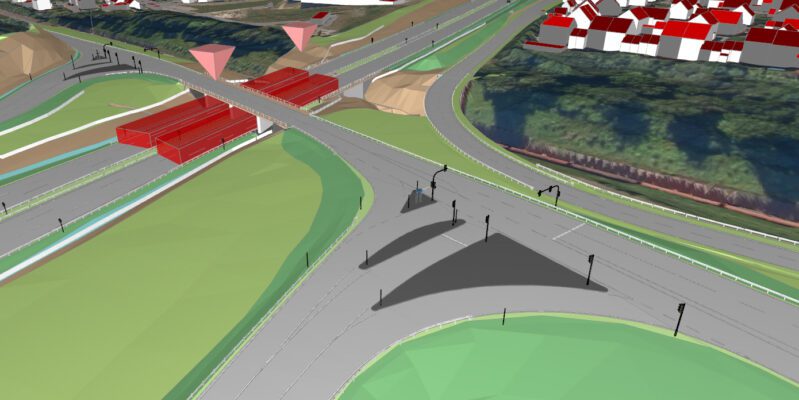Building Information Modelling (BIM) in transport infrastructure

In order to set up a project for the future in accordance with the BIM masterplan for federal trunk road construction, the BIM methodology must be implemented in the design process right from the start. This modern design method ensures the quality of the design results and avoids duplication of work.
KOCKS ENGINEERS have been working for almost two decades on the topic of how added value can be created from 3D model generation for our own machining process and thus also for our customers. The following applications regularly emerge:
- Checking clearances
- Checking stopping sight distances
- Collision checking
- Quantity determination
- Integration of subsoil horizons and seals
- Visualisation
- Transfer of 3D model content to 2D plans, avoidance of transfer errors
- Linking traffic system – immission control – civil engineering
Model-based design has advantages over conventional processing, especially when the planning results of different specialist planners have to be coordinated at an early design stage. In the major project ‘Eight-lane expansion of the A 1 motorway between the Cologne-Niehl interchange and the Leverkusen-West interchange, including the Leverkusen Rhine bridge’, which was under particular public pressure, the models helped to effectively and efficiently design the coordination process between roads, civil engineering and landfill construction.
In the project ‘Reconstruction of the Charlottenburg motorway junction and the replacement of the Rudolf-Wissell-Bridge’, the conditions for model-based approval are being created. To this end, KOCKS ENGINEERS have developed a modelling method with which the results of the noise investigation can be entered into a coordination model as a partial model. The result display of the partial model corresponds to the level result lists suitable for design approval.
Since 2023, KOCKS ENGINEERS have been preparing the road design for the six-lane expansion of the A 3 motorway between the Nittendorf junction and the Regensburg interchange. In this project, all the formalities of BIM design (AIA, BAP, attribution, model creation and model checking) are already being used in the preliminary design phase.